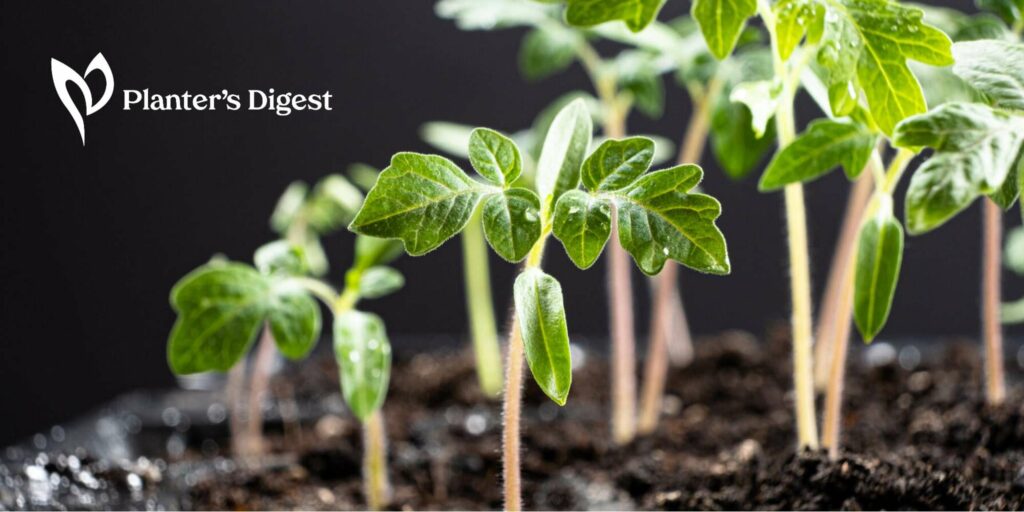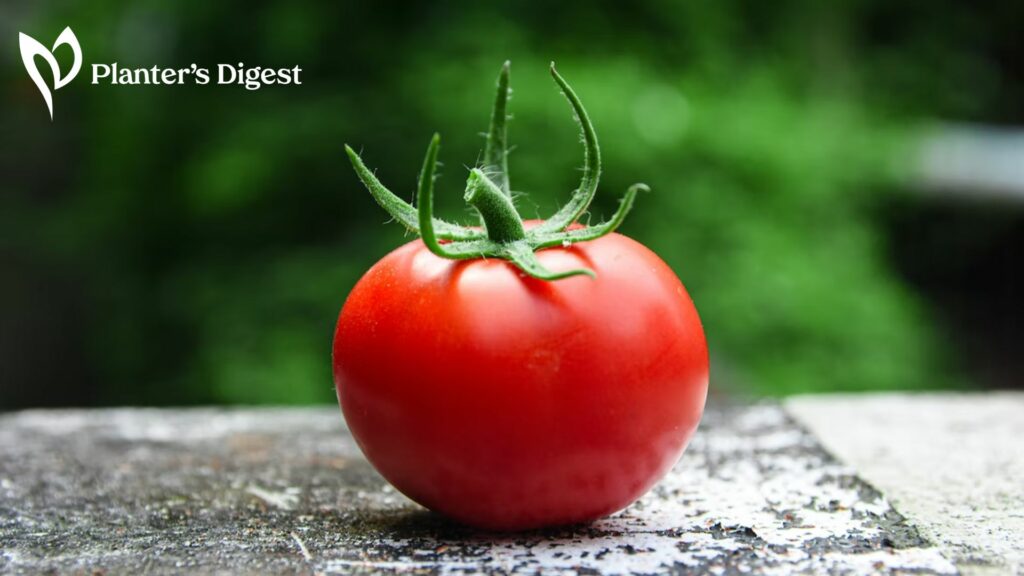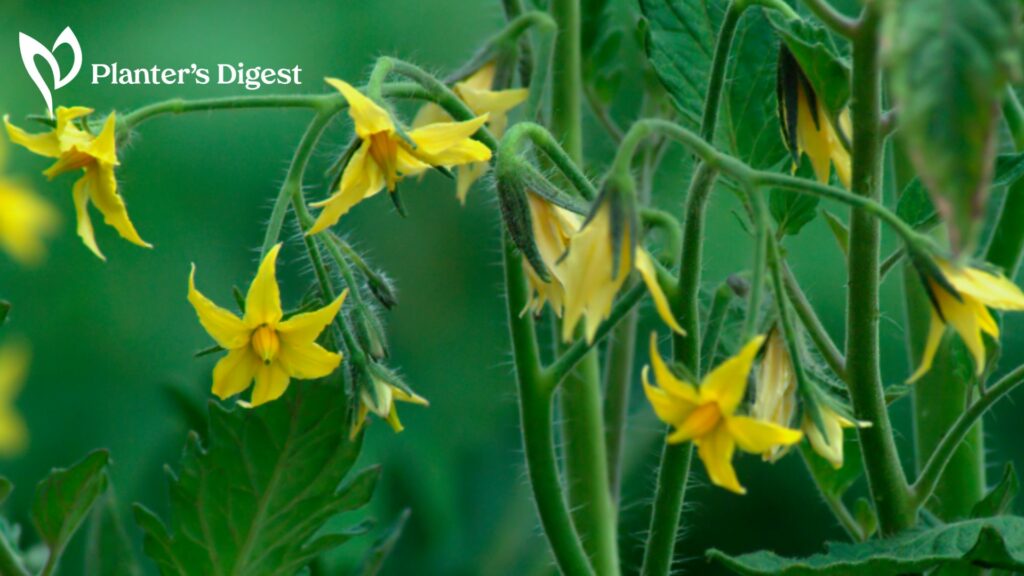Gardening timelines follow unique rhythms since the tomato plant dances to its own beat! It usually takes about 110 to 160 days for tomatoes to bear fruit.
There are various phases that the tomato plant undergoes, from seed to fruit development. Let’s check each phase in greater detail!
Phases of Tomato Growth
All fruiting plants follow a simple four-phase growth timeline. However, the duration of each phase can differ due to genetics and growing conditions.
Understanding these timeframes will help you plan when to start cultivating tomato seeds for a harvestable yield before the initial frost hits.
If you’re in a chilly region with a short growing season, you might want to initiate seed growth indoors and go for fast-maturing tomato varieties.
Seed Germination
From planting a seed to seeing it sprout, it takes about 7 to 14 days or roughly 1 to 2 weeks under the right conditions. But what exactly qualifies as these optimal conditions in terms of the moisture level and temperature of the soil?
Getting the Moisture Right for Tomato Seed Germination
Having the right soil moisture is essentially about keeping the soil damp, but not excessively wet. If the soil becomes dry, the seeds might struggle due to a lack of water before they even begin to sprout.
Equally risky, if not more so, is overwatering to the point where young seedlings fall prey to fungal diseases like damping off. Be on the lookout for drooping leaves, brown stems, or mold on the soil surface, as these are indicators of overwatering.
To maintain consistent moisture levels, lightly mist your seedlings with a spray bottle and use a humidity dome to trap moisture over the tray.
The Optimal Soil Temperature for Tomato Seed Germination
For the best results, the soil temperature should be kept between 65 and 85 F for tomato seed germination. Tomato seeds can sprout in as little as 6 days when the soil temperature ranges from 77 to 86 F.
If the soil temperature is around 50 F, it might take 43 days or about 6 weeks for tomato seeds to start growing. Anything below this temperature, and your tomato seeds won’t even begin to sprout.
On the other end, if the soil temperature climbs above 95 F, your tomato seeds will also shy away from sprouting. Naturally, the time it takes for seeds to germinate can vary slightly depending on the specific tomato variety you’re working with.
If the soil temperature falls within the optimal range but your tomato seeds are still showing no signs of life, remember that seeds older than 3 years tend to have a lower germination rate.
If you’re keen on speeding up the germination process, you can experiment with adjusting the soil temperature, moisture levels, and even the circulation of air.
Seedling Growth
From germination to transplanting outdoors, it typically spans 57 to 60 days or about 8 to 8.5 weeks.
But don’t be in a rush! It’s wise to hold off on transplanting your tomatoes until all threats of frost have disappeared.
The sweet spot for the duration between sowing your seeds and moving the plants outside is around 9 to 10 weeks, or 65 to 70 days.
With tomato seeds taking about 7 to 10 days to wake up and start growing, we can break down the time frame to about 55 to 60 days for the actual seedling development.
So, what’s the practical timeline? Begin the indoor cultivation of your tomato seeds approximately 6 to 8 weeks, or 40 to 60 days, before the final frost date of spring.
Then, when that chill is no longer a concern, transplant them outdoors, ideally within 1 to 3 weeks, or 7 to 21 days, after the last spring frost date.
Flower Development
Tomato plants can show off their fruit-producing magic anywhere from 0 to 21 days after being transplanted. Yes, you heard that right, sometimes those little green gems can start forming even before they’re moved outside!
Now, on the other side of the spectrum, it might take up to 21 days post-transplant for those lovely tomato flowers to make their debut. So, remember to mark your calendar with the big day you transplanted them.
If weeks fly by and you’re still not seeing any floral action, it’s probably a good time to roll up your sleeves and do a bit of troubleshooting. There are a few suspects that could be behind the scenes causing poor flower production in your tomato patch:
Soil That’s Too Wet or Too Dry
If your soil is excessively wet, it becomes waterlogged, depriving the plant roots of oxygen and causing them to suffocate. This not only hinders root development but can also lead to root rot and other fungal diseases.
On the other hand, soil that’s too dry lacks the necessary moisture for optimal nutrient absorption and overall plant health.
In overly dry conditions, tomato plants struggle to establish themselves and may fail to flower or produce fruit, as they divert their energy to survival rather than growth and reproduction.
Temperature Extremes
Just like us, tomatoes thrive when the temperature is just right—neither too scorching nor too chilly. If it’s sweltering hot, tomato plants might start feeling wilted and exhausted, focusing more on surviving than on producing flowers.
On the flip side, if it’s too cold, their enthusiasm for blooming takes a hit, and they might hunker down to conserve energy.
Shade Woes
Too much shade from towering trees or imposing buildings can throw a wet blanket on your tomato’s flowering enthusiasm. Sunlight is like their energy drink as it powers the process of photosynthesis, where they turn light into energy to grow, flower, and fruit.
So, if they’re stuck in the shade for too long, they won’t have the energy to produce those beautiful flowers that eventually turn into tasty tomatoes.
Nitrogen Overload
Nitrogen is a crucial nutrient for plant growth, and it’s often found in fertilizers. If your tomato plants get too much nitrogen, they might focus too much on growing lush green leaves.
They could end up forgetting about their main mission, which is producing those juicy, delicious tomatoes you’re eagerly anticipating.
In other words, they become obsessed with foliage and lose sight of their ultimate goal. So, while some nitrogen is essential, finding the right balance is crucial to ensure your tomato plants stay on track toward a fruitful harvest.
Fruit Development
Depending on the tomato plant type, you’ll usually see fruits forming within 50 to 100 days after planting the seedling in your garden.
For a simpler approach, you can grab well-established plants from local nurseries. Alternatively, you can place an order online and have them conveniently brought to your doorstep.
Once successful self-pollination happens, the tomato plants get going and start producing fruit around 28 to 85 days after the blossoms show up. Just remember that the exact timing can vary based on the specific kind.
If you’re eager for quick results, think about experimenting with fast-maturing tomato varieties. On the other hand, some tomato types take notably longer to reach the fruiting stage.
Once the first set of fruit shows up, your tomato plants can continue to produce for several weeks or even months, extending their productivity until the first autumn frost arrives.
For the best results, you might want to stretch their growing season by using a greenhouse or providing suitable cold protection measures, like employing protective row covers.
Factors That Affect Fruit on Tomato Plants
Some factors can come into play in how tomato plants start producing fruit. Let’s go over them briefly so we know what to do and what to avoid.
Soil Temperature and Seed Germination
Cold soil temperatures can put the brakes on seed germination. This occurs because the vital processes required for germination tend to slow down in colder soil.
Monitor the warmth of the soil closely. The best soil temperature is anything above 50°F, preferably hovering around 60°F.
Temperature’s Impact on Seedling Growth
Chilly weather can really influence the speed of seedling growth. When they’re subjected to colder temperatures, their growth rate tends to slow down.
Worse, these colder conditions pose hurdles to the development of seedlings. To foster optimal growth, aim to maintain a temperature range of 70 to 80 F for your tomatoes.
The Role of Pollinators
Pollinators, like bees, have a crucial role in how plants reproduce. They help by transferring pollen between flowers, a vital step in this whole process.
If we don’t have enough pollinators, like bees and butterflies, doing their thing, the whole pollination and fertilization process can slow down. That’s bad news because it can mean less fruit and not-so-happy plants due to the pollinators’ absence.
So, when you can, steer clear of systemic insecticides. These harmful chemicals can mess with the bees and we might end up with an imbalanced ecosystem.
Tomato Plant Resilience
Tomatoes are hardy in cooler conditions, enduring temperatures as low as 33 F. Still, it’s important to be cautious when the thermometer falls below 40 F.
You might see a growth slowdown and a delay in the blossoming process. To ensure their strong growth, we recommend consistently monitoring the temperature.
Temperature’s Influence on Growth and Climate
Rising temperatures speed up plant growth. Cooler conditions can put the brakes on it.
These temperature fluctuations play a role in shaping the garden’s overall climate. This has a direct influence on humidity and moisture levels.
When thrown together, these factors determine the well-being and productivity of your plants.
Variety Selection
Each tomato variety has its own fruit-bearing growth pattern. Certain tomatoes are bred to give early harvests, allowing you access to fresh tomatoes sooner in the season.
In contrast, other varieties might require more time to mature but result in larger or more flavorful fruits. All that’s important is selecting the right cultivars that serve your purposes.
Soil Health
Maintaining nutrient-rich soil is essential for promoting robust plant growth. This kind of soil furnishes plants with the necessary elements for their development.
This ensures a consistent supply of vital minerals throughout their entire life cycle. Emphasizing the significance of effective drainage remains a constant in our advice.
Adequate drainage stands as a pivotal element in averting waterlogging. When your tomato gets waterlogged, it can ultimately result in root rot.
The Role of Light and Sunlight
The importance of light, especially sunlight, in nurturing tomato plants cannot be emphasized enough. These plants rely on ample sunlight for their growth and progress.
Inadequate light affects flower and fruit production. At the same time, low light conditions also undermine plant vitality and well-being.
Why does my tomato plant produce flowers but not fruits?
The absence of fruit despite flowering in tomato plants can be due to pollination issues, environmental stressors, nutrient imbalances, over-fertilization, improper watering, disease or pest infestations, incorrect pruning, variety characteristics, or genetic factors.
Curious about these issues? Let’s take a quick look so we can try to prevent them from happening.
Pollination Issues
Tomatoes require proper pollination for fruit development. A lack of bees or disruptions in weather conditions can cause flowers to drop before bearing fruit.
Cold temperatures, ideally around 50 F, are optimal for bee activity. Bee activity, in colder weather, tends to slow down.
Excessive humidity can hinder pollen release too. On the other hand, dry conditions may prevent pollen from sticking to female flowers.
Problems like inadequate watering, insufficient sunlight, nutrient deficiencies, pests, and diseases can stress tomato plants. Ultimately, it can result in a lack of flowers or fruit.
If your tomatoes bloom too early, don’t remove these premature blooms. Instead, protect the plants from cold weather and use a well-balanced tomato-specific fertilizer.
Environmental Stress
Tomatoes are sensitive to temperature changes. High temperatures exceeding 90 F hinder fruit setting.
Cold nights below 50 F can lead to flowers dropping before fruiting.
Humidity poses challenges for tomatoes as well. Insufficient humidity dries out flowers, whereas excessive humidity disrupts pollination.
Adequate sunlight is important for successful tomato fruiting. Shade caused by plants or nearby structures can end up with fewer flowers and delayed fruit development.
Water availability is crucial as drought causes leaf wilting, flower loss, and fruit death. On the other hand, excessive water causes root rot and nutrient imbalances, affecting fruit growth.
Poor soil quality negatively impacts root health and nutrient absorption. This can lead to reduced flower and fruit production.
Strong winds can break stems and flowers. This can easily end up disrupting the fruiting process.
Artificial nighttime light disturbs the plant’s natural rhythms. Once this happens, there is visible harm to the flowering and fruiting patterns.
Finally, polluted air, often found in urban areas, damages tissue and disrupts photosynthesis. Ultimately, these conditions can lead to poor fruit quality, if any at all.
Nutrient Imbalance
Unbalanced nutrients can disrupt tomato growth and fruiting. We can’t emphasize the need enough for a balanced combination of nitrogen, phosphorus, and potassium.
Nitrogen drives leafy growth. Excess can eclipse flower and fruit development, leading to a “vegetative imbalance” where energy prioritizes leaves over reproductive structures.
Phosphorus influences root strength, flowering, and fruiting. Insufficient levels result in weak roots, delayed flowering, and subpar fruit.
On the other hand, too much phosphorus content enhances flower buds, pollination, and fruit quality.
Potassium contributes to overall health, stress resilience, and fruit excellence. Its deficiency hampers nutrient transport, hindering flower and fruit growth.
Excess amounts can also leave plants vulnerable to diseases and environmental challenges.
Over-Fertilization
Excessive feeding harms tomatoes. Tomatoes can get overwhelmed with too much nitrogen, phosphorus, and potassium.
Now remember that while these nutrients are beneficial, their overuse disrupts plant health and fruiting. The imbalance affects nutrient ratios.
The result is a shift in energy allocation away from flowers and fruit. Excess nitrogen encourages leaf growth but hinders fruit development.
This usually leads to excessive flowers that drop prematurely, preventing fruit formation. This nutrient imbalance also invites pests and diseases, further impacting fruit quality.
Overfeeding-induced calcium deficiency can trigger “blossom end rot”. When this happens, tomatoes develop sunken, dark, and leathery bottoms due to insufficient calcium levels.
Watering Practices
Maintaining a consistent watering schedule is essential to prevent plant stress, flower drop, and inadequate fruiting. To avoid drought-related strain, maintain a regular watering schedule.
Tomatoes establish deep roots to access water from various levels. This means deep watering is extremely beneficial for tomatoes, especially during dry spells.
Watering in the morning aids daytime drying as it’s a key factor in preventing fungal diseases. Avoid evening watering to prevent overnight dampness and disease development.
Mulch helps to retain soil moisture, reduce evaporation, and inhibit weed growth. Apply 2 to 3 inches of mulch around the base, while keeping it clear of the stem.
Next, go for low, base-level watering instead of overhead watering. This will help to prevent fungus attraction on wet leaves.
The practice of watering deeply and infrequently encourages deeper root growth. At the same time, you’ll ensure that your tomato is more resilient to drought conditions.
Disease or Pest Infestation
Diseases and pests harm flowers, disrupt pollination, and hinder fruit growth. Diseases like blossom end rot from calcium deficiency can lead to flower loss before fruiting.
When it comes to pests, aphids, whiteflies, and spider mites damage flowers and overall plant health. Even worse, some pests and diseases spread harmful microorganisms that infect the plant’s vascular system, affecting nutrient and water transport.
Fungi like Fusarium wilt or bacterial diseases like bacterial spot make flowers fall early, reducing fruiting potential. Infected plants focus on fighting these problems, often sacrificing fruiting.
Improper Pruning
Pruning is a must for managing plant growth and improving airflow, but too much or incorrect pruning can accidentally remove important flower buds and disrupt growth.
Tomato plants create flowers at the tips of branches. Excessive pruning here can lead to fewer flowers and, thus, fewer fruits.
Cutting too many leaves can limit photosynthesis, lowering energy for fruiting. Also, timing matters – wrong timing or cutting too close to the main stem can stress the plant and stop flowers from forming.
Focus on pruning lower, older leaves – they might spread disease or shade young fruit. This boosts air circulation, sunlight, and plant health. Be careful not to cut flowering branches; they’re needed for fruit clusters.
Variety Characteristics
Every type of tomato has its own special genetic makeup that affects how it grows, blooms, and produces fruit. Some produce fruit early or late, sticking firmly to their unique schedules for flowering and fruiting.
Some start by growing lots of leaves, building a strong plant before concentrating on making fruit. There are also those that handle tough conditions well, managing to make fruit even when things aren’t perfect.
Some kinds of tomatoes even need specific cues from the environment. These could be in the form of certain lengths of days or temperature ranges to start making fruit successfully.
Genetic Factors
Many tomato varieties show unique characteristics solely influenced by their genetics. Some kinds might naturally display traits that cause delayed fruiting or hinder the conversion of flowers into mature fruits.
These traits may involve a preference for leafy growth over reproduction. This could mean yielding more leaves and fewer fruits.
In certain instances, genetic mutations or variations could result in irregular flower development or limited pollen production. These anomalies might lead to incomplete pollination, curbing fruit formation.
Plus, particular tomato varieties may depend on specific surroundings or pollinators to spark fruitful growth. Thus, any deviation from these conditions can affect fruit production.





